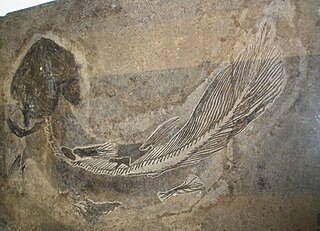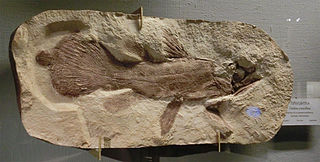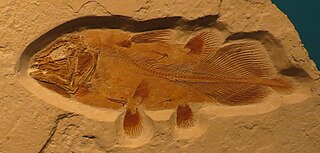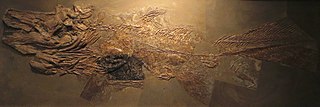
Coelacanths are an ancient group of lobe-finned fish (Sarcopterygii) in the class Actinistia. As sarcopterygians, they are more closely related to lungfish and tetrapods than to ray-finned fish.

Caturus is an extinct genus of predatory marine fishes in the family Caturidae in the order Amiiformes, related to modern bowfin. It has been suggested that the genus is non-monophyletic with respect to other caturid genera.

Thrissops is an extinct genus of stem-teleost fish from the Jurassic period. Its fossils are known from the Solnhofen Limestone, as well as the Kimmeridge Clay.

Pleurosaurus is an extinct genus of aquatic reptiles belonging to the order Rhynchocephalia. Pleurosaurus fossils have primarily been discovered in the Solnhofen Limestone of Bavaria, Germany and the Canjuers lagerstatte near Canjuers, France, both dating to the Late Jurassic. It contains two species, P. goldfussi and P. ginsburgi.

Mesolimulus is an extinct genus of horseshoe crab. The best known examples are found in Solnhofen limestone near Solnhofen, Bavaria, Germany. Originally assigned to the living genus Limulus, they are related to and look virtually identical to modern horseshoe crabs. Other species assigned to Mesolimulus have been recorded spanning over 140 million years from the Middle Triassic to Late Cretaceous from England, Spain, Siberia and Morocco.

Latimeriidae is the only extant family of coelacanths, an ancient lineage of lobe-finned fish. It contains two extant species in the genus Latimeria, found in deep waters off the coasts of southern Africa and east-central Indonesia. In addition, several fossil genera are known from the Mesozoic of Europe, the Middle East, and the southeastern United States, dating back to the Triassic.

Coelacanthus is a genus of extinct marine coelacanths known from the late Permian period. It was the first genus of coelacanths described, about a century before the discovery of the extant coelacanth Latimeria. The order Coelacanthiformes is named after it.

Undina is a genus of prehistoric coelacanth, lobe-finned fish, which lived from the Triassic period to the Cretaceous period.

Libys is a genus of coelacanth fish in the family of Latimeriidae. Species of Libys lived during the Upper Jurassic period.

Ticinepomis is an extinct genus of coelacanth lobe-finned fish which lived during the Middle Triassic period in what is now Switzerland. It contains two species, T. peyeri and T. ducanensis.

Mawsonia is an extinct genus of prehistoric coelacanth fish. It is amongst the largest of all coelacanths, with one quadrate specimen possibly belonging to an individual measuring 5.3 metres in length. It lived in freshwater and brackish environments from the late Jurassic to the mid-Cretaceous of South America, eastern North America, and Africa. Mawsonia was first described by British paleontologist Arthur Smith Woodward in 1907.

Holophagus is an extinct genus of coelacanth belonging to Latimeriidae. The type species, Holophagus gulo, is known from the Lower Jurassic marine Lias of England. Some authors have considered the genus restricted to the Lias of England.
Changxingia is a genus of prehistoric marine lobe-finned fish that belonged to the coelacanth family Mawsoniidae. It lived during the Late Permian in Zhejiang, southern China. It contains two species, C. aspiratilisWang & Liu, 1981 and C. weiiJin, 1997, which were named in 1981 and 1997 from specimens found at the same locality. They are the first Permian marine coelacanths found in Asia.

Mawsoniidae is an extinct family of prehistoric coelacanth fishes which lived during the Triassic to Cretaceous periods. Members of the family are distinguished from their sister group, the Latimeriidae by the presence of ossified ribs, a coarse rugose texture on the dermatocranium and cheek bones, the absence of the suboperculum and the spiracular, and reduction or loss of the descending process of the supratemporal. Mawsoniids are known from North America, Europe, South America, Africa, Madagascar and Asia. Unlike Latimeriidae, which are exclusively marine, Mawsoniidae were also native to freshwater and brackish environments. Mawsoniids represent among the youngest known coelacanths, with the youngest known remains of the freshwater genus Axelrodichthys from France and an indeterminate marine species from Morocco being from the final stage of the Cretaceous, the Maastrichtian, roughly equivalent in age to the youngest known fossils of latimeriids. Species of Mawsonia and Trachymetopon are known to have exceeded 5 metres in length, making them among the largest known bony fish to have ever existed.

Whiteia is an extinct genus of prehistoric coelacanth fish which lived during the Triassic period. It is named after Errol White.

Laugiidae is an extinct family of prehistoric marine coelacanths which lived during the Triassic and Jurassic periods. Their fossils have been found in Canada, Germany and Greenland.
Lualabaea is an extinct genus of prehistoric freshwater coelacanth, belonging to the family Mawsoniidae, from the Jurassic period. It contains two species, L. lericheiSaint-Seine, 1955 and L. henryiSaint-Seine, 1955, both known from the Stanleyville Formation of the Democratic Republic of the Congo. It may be related to or possibly synonymous with Axelrodichthys.

Heptanema is an extinct genus of prehistoric coelacanth from the Middle Triassic (Ladinian) of northern Italy and southern Switzerland.

Trachymetopon is an extinct genus of prehistoric coelacanth from the Jurassic of Europe. Fossils have been found in the Early Jurassic Posidonia Shale of Germany the Middle Jurassic Marnes de Dives of France, and probably the Late Jurassic Kimmeridge Clay of England. Only one species has been named, Trachymetopon liassicum, described by Henning in 1951 from an almost complete specimen found in the Lower Toarcian of Ohmden in Baden-Württemberg. Another specimen is known from the same site, and two older specimens come from the Sinemurian of Holzmaden. The holotype of this species is 1.6 metres in length. A giant specimen of an undetermined species of Trachymetopon found at the Middle Jurassic Falaises des Vaches Noires of Normandy. This specimen, composed of a 53 cm long palatoquadrate, belongs to an individual 4 metres (13 ft) in length. A basisphenoid found in a museum in Switzerland that likely originates from the same locaity probably belonged to an individual around 5 m (16 ft) long, making Trachymetopon the largest of all coelacanths alongside Mawsonia. A study published in 2015 revealed that this coelacanth belongs to the Mawsoniidae. Trachymetopon is one of the few known mawsoniids to have been exclusively marine, while most of the other members of the group have lived in fresh and brackish waters.

Foreyia is an extinct genus of coelacanth lobe-finned fish which lived during the Middle Triassic period in what is now Canton of Graubünden, Switzerland. It contains a single species F. maxkuhni.






















